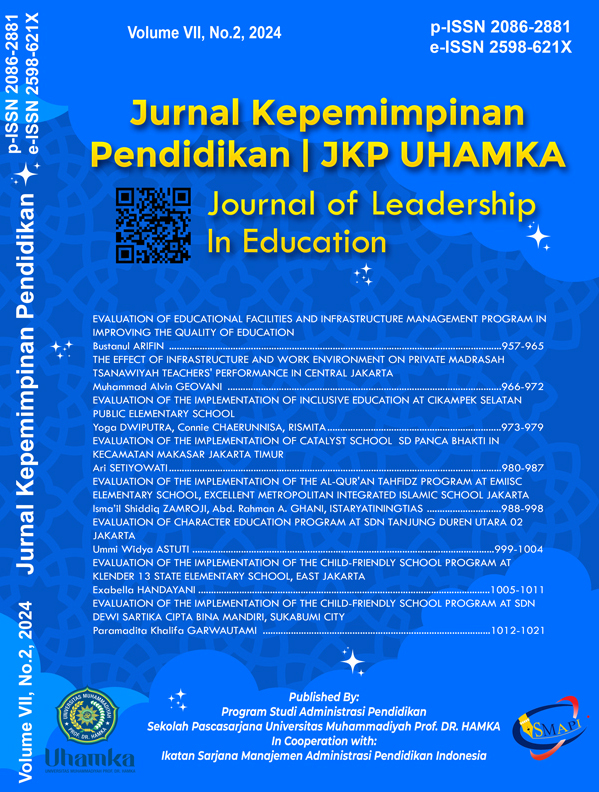EVALUATION OF CHARACTER EDUCATION PROGRAM AT SDN TANJUNG DUREN UTARA 02 JAKARTA
DOI:
https://doi.org/10.22236/jkpuhamka.v7i2.18229Keywords:
program evaluation, Character Education, CIPP ModelAbstract
This study evaluates the implementation and success of the character education program at SDN Tanjung Duren Utara 02 Jakarta using the CIPP model (Context, Input, Process, Product). The research aims to identify strengths and gaps in the program while providing recommendations for improvement. Participants include the principal, teachers, and parents, with data collected through interviews, observations, and documentation, then analyzed descriptively and qualitatively. The findings indicate that the program has met most evaluation criteria but requires improvement. In the context stage, the program’s vision, mission, and objectives have been effectively socialized, but the absence of a formal implementation team decree (SK) leads to varied understandings of roles and responsibilities. The input stage highlights a need for stronger principal supervision and improvements in facilities to support consistent program quality. In the process stage, teachers are encouraged to apply character values more consistently in both classroom and extracurricular activities. The product stage shows promising results in fostering character education among students, but limited monitoring and evaluation reduce the program's overall effectiveness in achieving its goals. Overall, the character education program is categorized as sufficient but requires further development. Recommendations include formalizing the program structure through an implementation team decree, increasing principal oversight, ensuring consistent application of character values, and conducting regular and systematic evaluations to optimize program outcomes.
Downloads
References
Berkowitz, M. W., Pelster, K., & Johnston, A. (2012). Leading in the middle: A tale of pro-social education reform in two principals and two middle schools. The handbook of prosocial education, 2, 619-626. https://static1.squarespace.com/static/5c6c5f928d974068cfa15797/t/5c9cef247817f77c6b 61d64e/1553788708649/LACE+case+study+on+pro-social+education.pdf
Berkowitz, M., & Hoppe, M. A. (2009). Character education and gifted children. High Ability Studies, 20(2), 131–142. https://eric.ed.gov/?id=EJ870495
Cansoy, R. (2019). The relationship between school principals’ leadership behaviors and teachers’ job satisfaction: A systematic review. International Education Studies, 12(1), 37–52. https://files.eric.ed.gov/fulltext/EJ1201517.pdf
Dunlap, J., Li, J., & Kladifko, R. (2015). Competencies for effective school leadership: To what extent are they included in Ed.D. leadership programs? Educational Leadership and Administration: Teaching and Program Development, 26, 14–26. https://files.eric.ed.gov/fulltext/EJ1062258.pdf
Elias, M. (2010). Character education: Better students, better people. Education Digest: Essential Readings Condensed for Quick Review, 75(7), 47–49. https://eric.ed.gov/?id=EJ873658
Farikah. (2019). Developing the students’ character through literacy activities in a child-friendly school model. Dinamika Ilmu, 19(2), 187–196. https://files.eric.ed.gov/fulltext/EJ1236089.pdf
Goss, S. J., & Holt, C. R. (2014). Perceived impact of a character education program at a Midwest rural middle school: A case study. Education Leadership Review of Doctoral Research, 1(2), 49–64. https://eric.ed.gov/?id=EJ1105748
Holtzapple, C. K., Griswold, J. S., Cirillo, K., Rosebrock, J., Nouza, N., & Berry, C. (2011). Implementation of a school-wide adolescent character education and prevention program: Evaluating the relationships between principal support, faculty implementation, and student outcomes. Journal of Research in Character Education, 9(1), 71–90. https://link.gale.com/apps/doc/A284015981/EAIM?u=naal_sam&sid=bookmarkEAIM&xid=9d397e38
Huff, J., Preston, C., Goldring, E., & Guthrie, J. E. (2018). Learning-centered leadership practices for effective high schools serving at-risk students. Teachers College Record, 120(9), 1–38. https://doi.org/10.1177/016146811812000905
Jeynes, W. H. (2017). A meta-analysis on the relationship between character education and student achievement and behavioral outcomes. Education and Urban Society, 51(1), 3371. https://doi.org/10.1177/0013124517747681
Leithwood, K., Sun, J., & Schumacker, R. (2020). How school leadership influences student learning: A test of “The four paths model.” Educational Administration Quarterly, 56(4), 570–599. https://doi.org/10.1177/0013161X19878772
Marvul, J. N. (2012). If you build it, they will come: A successful truancy intervention program in a small high school. Urban Education, 47(1), 144–169. https://doi.org/10.1177/0042085911427738
Mombourquette, C. (2017). The role of vision in effective school leadership. International Studies in Educational Administration (Commonwealth Council for Educational Administration & Management (CCEAM)), 45(1), 19–36. https://cceam.net/wpcontent/uploads/2019/01/ISEA_2017_45_1.pdf#page=25
Pala, A. (2011). The need for character education. International Journal of Social Sciences and Humanity Studies, 3(2), 23-32.
Silverthorn, N., DuBois, D. L., Lewis, K. M., Reed, A., Bavarian, N., Day, J., Ji, P., Acock, A. C., Vuchinich, S., & Flay, B. R. (2017). Effects of a school-based social-emotional and character development program on self-esteem levels and processes: A clusterrandomized controlled trial. SAGE Open, 7(3), 1-12. https://doi.org/10.1177/2158244017713238
Stephens, J. M., & Wangaard, D. B. (2013). Using the epidemic of academic dishonesty as an opportunity for character education: A three-year mixed methods study (with mixed results). Peabody Journal of Education, 88(2), 159–179. https://www.jstor.org/stable/42001753
Stephens, J. M., & Wangaard, D. B. (2016). The “achieving with integrity” seminar: An integrative approach to promoting moral development in secondary school classrooms. International Journal for Educational Integrity, 12. https://doi.org/10.1007/s40979-016-0010-1
Stiff-Williams, H. (2010). Widening the lens to teach character education alongside standards curriculum. Clearing House, 83(4), 115–120.
Sun, J., Johnson, B., & Przybylski, R. (2016). Leading with data: An increasingly important feature of school leadership. International Studies in Educational Administration (Commonwealth Council for Educational Administration & Management (CCEAM)), 44(3), 93–128.
Thornton, B., Usinger, J., & Sanchez, J. (2019). Leading effective building level change. Education, 139(3), 131. https://eric.ed.gov/?id=EJ1320691
Urick, A. (2020). What type of school leadership makes teachers want to stay? NASSP Bulletin, 104(3), 145–176. https://journals.sagepub.com/doi/10.1177/0192636520949682
Webster, K., & Litchka, P. (2020). Planning for effective school leadership: Teachers’ perceptions of the leadership skills and ethical behaviors of school principals. Educational Planning, 27(1), 31–47. https://eric.ed.gov/?id=EJ1250500
Williams, D. D., Yanchar, S. C., Jensen, L. C., & Lewis, C. (2003). Character Education in a public high school: A multi-year inquiry into unified studies. Journal of Moral Education, 32(1), 3-33. https://doi.org/10.1080/0305724022000073310
Downloads
Published
How to Cite
Issue
Section
License
Copyright (c) 2025 Ummi Widya ASTUTI

This work is licensed under a Creative Commons Attribution 4.0 International License.















